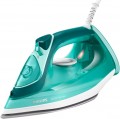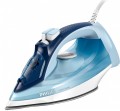Coating of the working surface
Iron soleplate cover. This surface is in direct contact with the fabric, and therefore the type of coating is one of the most important characteristics.
—
Aluminium. Aluminium, being a simple and cost-effective choice, offers advantages such as low weight and rapid heating. However, it is prone to quick scratching, diminishing ironing quality and potentially damaging processed fabrics. Overheating may cause aluminium to stick to fabric, posing cleaning challenges. As a result, "pure" aluminium is often found in the most budget-friendly or compact irons. Some manufacturers employ special technologies in aluminium soleplates to mitigate these drawbacks to some extent.
—
Stainless steel. Inexpensive and at the same time very practical material, the most common version of the metal soleplate in modern irons. True to its name, "stainless steel" is highly resistant to corrosion, yet it is durable, free of scratches and burrs, glides well and is easy to clean. Of the significant shortcomings of this material, one can only note a rather large weight.
—
Ceramic. The main advantage of ceramics is that it glides much better than steel or aluminium. In addition, this material is easy to clean and practically does not scratch. On the other hand, ceramic soleplates are quite fragile and can break or chip from a strong impact.
—
Metal-ceramic. Material generally similar to the ceramics described above; may be somewhat stronger due to the addition of metals, but in fact it all depends on the specific composition.
— Tourmaline. Another type of ceramic material containing tourmaline is a natural semi-precious stone. A feature of tourmaline soleplates is a natural antistatic effect, which is especially useful when ironing light fabrics: such fabrics will not stick to the soleplate due to static charge.
—
Titanium/ceramics. Metal-ceramic (see above), which includes titanium. This metal is characterized by high strength and wear resistance, which has a positive effect on the overall reliability of the soleplate.
—
Teflon. Teflon (polytetrafluoroethylene) enables smooth gliding of the iron over fabric and offers non-stick properties. This coating is easily cleaned, resists sticking to clothes, and remains relatively clean even in situations like overheating and burning through materials. However, a notable drawback of Teflon is its high sensitivity to scratches, necessitating caution when ironing items with metal buttons, fasteners, or decorative elements.
—
Non- stick. This category includes all types of non-teflon non-stick coatings (see above). The specific composition and properties of such a coating may be different. For example, in some models it is the same PTFE, just not called Teflon (the word "Teflon" is a registered trademark and may not be used without permission). In addition, there are other materials. A common feature of all such coatings is that almost no dirt sticks to them, which greatly simplifies the cleaning of the soleplate.
—
Titanium. One of the most advanced options. Titanium is extremely durable and virtually unaffected by chips and scratches, even from falls and other serious "accidents". On the other hand, it does not heat up very quickly, but is very expensive. Therefore, such a coating is rare, mainly in premium irons.
—
Enamelled. Typically, these soleplates feature a stainless steel base with a specialized enamel coating. The enamel composition is chosen for both smooth gliding and durability. The primary advantage lies in the reliability of this coating, which is highly resistant to scratches—many enameled soleplates can withstand cleaning with metal brushes. However, it's worth noting that irons with such coatings come with a corresponding higher cost.
Steam supply power
The steam supply power provided by an iron is essentially the amount of steam supplied by the device per minute. In most modern irons, the intensity of steaming can be adjusted, so this item usually indicates the maximum power value.
The more steam the iron supplies, the more intense the effect on the fabric, the more dense and rigid materials can be effectively smoothed out without resorting to a steam boost (see below). On the other hand, high performance significantly affects the price, dimensions and weight of the iron. Accordingly, it is worth choosing according to this indicator taking into account the planned method of application — especially since the full power of steam is far from always required, and in special cases the same steam boost can be used.
In travel and simple household irons, the productivity is about 15 – 30 g/min. More than 30 g/min corresponds to enhanced steaming, and the most advanced devices, mainly for professional use, are capable of producing 60 g/min or more (the so-called “turbo mode”).
Water tank volume
The volume of the water tank installed in the iron.
The water from this container is used to generate steam when steaming fabrics. In modern models of irons, the tanks are made of transparent materials and are provided with a lid at the opening through which water is poured. As for capacity, a large volume, on the one hand, allows you to work longer without refilling, on the other hand, it significantly makes the entire device heavier. Therefore, in classic models, where the tank is located on the iron itself, the capacity is usually small — about 80 ml for travel and 300 ml for household models. But there are also
irons with a large water tank, in which the volume can reach 500 ml. But for advanced steam generators and ironing systems (see "Type"), the tank is made separately, and in such cases its volume can be 1 L, and for
models with a large tank, figures of more than 1.5 L are typical.
Heating time
The time it takes the iron to go into working condition. In the case of classic household appliances, this is the time for heating the sole to the required temperature, which depends on the selected mode. For models with a steam generator, this is the time required to heat the water in the boiler.
Cable length
The length of the cable for connecting to the mains provided in the iron.
Manufacturers select the length of the cable, taking into account the general specialization of the iron and the characteristics of its application — so that the wire is enough for most cases and at the same time it is not too long and bulky. Therefore, in most cases, this parameter can be ignored; exceptions are only some specific situations. For example, if you choose a travel iron and compactness is a key criterion, you should choose a
shorter wire. A
long cable, in turn, will come in handy at a great distance from sockets and the absence of extension cords.
For clarity, we note that for household irons, the average cable length is 1.5 m.
Iron weight
The total weight of the iron. Usually, this parameter is indicated "dry", without water; and for steam generators and ironing systems (see "Type"), the weight of the iron is given, without additional equipment.
Initially, it was believed that the heavier the iron, the more efficiently it performs its task. However, modern models use various technical tricks to achieve good ironing quality with low weight. At the same time, a lighter iron is more “manoeuvrable” and easier to use, you can work with it for a long time without getting tired. Therefore, it makes sense to specifically look for a massive model only in cases where you plan to often work with difficult-to-iron, “unruly” fabrics — for example, natural linen: more weight will give additional processing efficiency.

